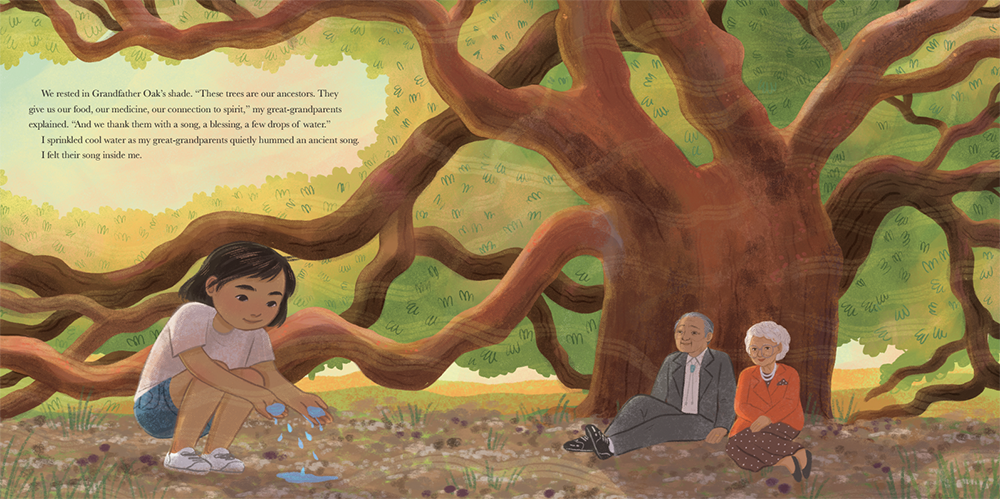
- Details
- By HarperCollins
Growing up Native can be hard. Because my skin was dark, in second grade kids told me, “You look dirty.” I felt different, like I didn’t belong.
But I was lucky. My great-grandparents Joe and Lodi showed me the beauty of our Indigenous cultures. Camping and hiking for days at a time in the hot summer desert, they taught me to hear the voices of our mountain, plant, and animal relatives on lands full of life and memory.
They taught me to listen to the plants offer their gifts. Buckwheat shared seeds to nourish us; wild strawberries to quench our thirst when streams ran dry; willow bark to help with headaches; and sage smoke to carry prayers to heaven. We gave thanks, with songs or a few drops of water. I was excited to learn it all. “Look at Nicky,” my great-grandparents would tease, “sticking his nose into every flower, just like a hummingbird.”
By the time I grew up, Joe and Lodi had passed. The lands I loved were bulldozed for parking lots and strip malls. I felt lost. I experienced times of addiction and homelessness, even sleeping on the sidewalk. Then one day I heard the voices of tiny milkweeds struggling in the concrete, just like I was. Their voices and the memories of my great-grandparents gave me strength not to give up, to start to heal myself.
I studied our native plants, collecting seeds and shoots to grow. I looked for places in the city where I could restore mini-habitats for birds and insects who need them so badly. I chose a name to honor my memories, and called myself Nick Hummingbird.
It still isn’t easy. With his long hair and dark skin, sometimes my son feels different from other kindergartners. We go on our tiny apartment balcony, water our seedlings, and listen to our plants. Maybe we’ll see a monarch or a hummingbird, connecting us to the beauty of all our relatives.
 Interior illustration from Can You Hear the Plants Speak? Illustrations copyright © 2024 by Madelyn Goodnight
Interior illustration from Can You Hear the Plants Speak? Illustrations copyright © 2024 by Madelyn Goodnight
I hope my book, Can You Hear the Plants Speak?, with Madelyn Goodnight’s wonderful illustrations, invites readers to deepen their relationship with the voices and the land where they live.
Nicholas Hummingbird is a native plant expert and plant activist. When Nicholas was a child, his Cahuilla and Apache great-grandparents taught him to listen to plants and how to steward their lands wisely and with respect. Today he keeps their memories and stories alive through his work restoring habitat and bringing nature back to concrete urban spaces. He and his young son, Tuhui, whose name means the first drop of rain, enjoy hiking, cooking, and reading picture books. Nicholas lives in Ventura, California. Visit him at nicholashummingbird.com.
Julia Wasson is an educator and curriculum designer. She and her husband tend a small native plant garden on their Hollywood curb strip. Their adult children live nearby. See more online at juliawassonbooks.com.
Madelyn Goodnight is a member of the Chickasaw Nation. Her work reflects her love of childhood. She holds a degree from Rhode Island School of Design and lives in Oklahoma City, Oklahoma. She is the illustrator of The Pear Tree; Look, Grandma! Ni, Elisi!; and Rock Your Mocs.
Help us defend tribal sovereignty.
At Native News Online, our mission is rooted in telling the stories that strengthen sovereignty and uplift Indigenous voices — not just at year’s end, but every single day.
Because of your generosity last year, we were able to keep our reporters on the ground in tribal communities, at national gatherings and in the halls of Congress — covering the issues that matter most to Indian Country: sovereignty, culture, education, health and economic opportunity.
That support sustained us through a tough year in 2025. Now, as we look to the year ahead, we need your help right now to ensure warrior journalism remains strong — reporting that defends tribal sovereignty, amplifies Native truth, and holds power accountable.
 The stakes couldn't be higher. Your support keeps Native voices heard, Native stories told and Native sovereignty defended.
The stakes couldn't be higher. Your support keeps Native voices heard, Native stories told and Native sovereignty defended.
Stand with Warrior Journalism today.
Levi Rickert (Potawatomi), Editor & Publisher
